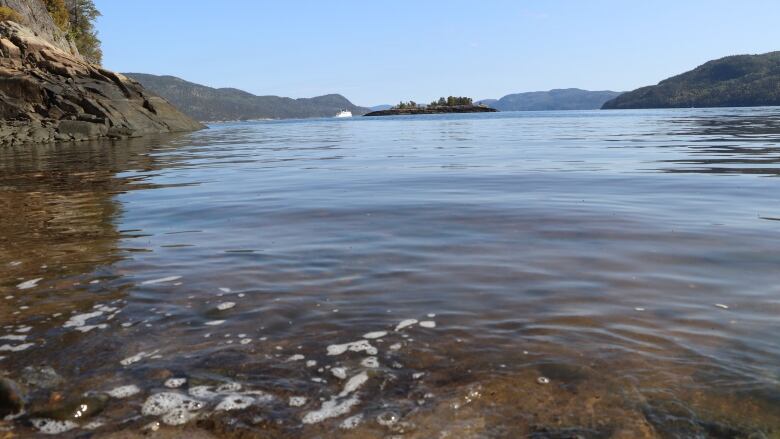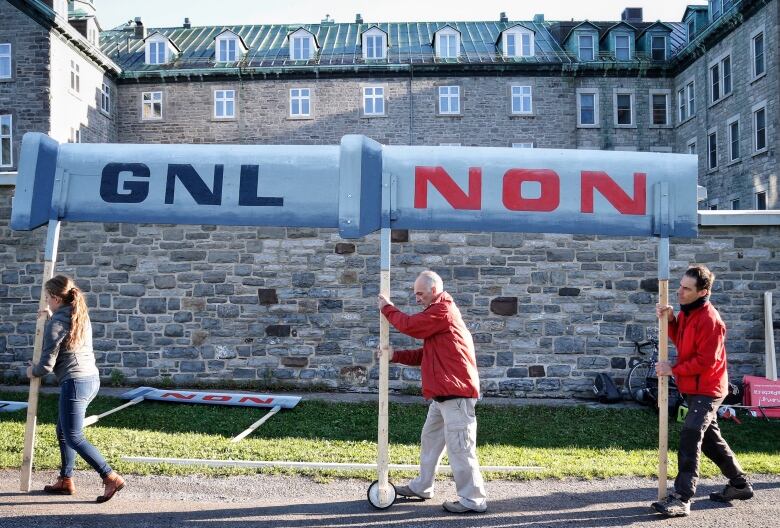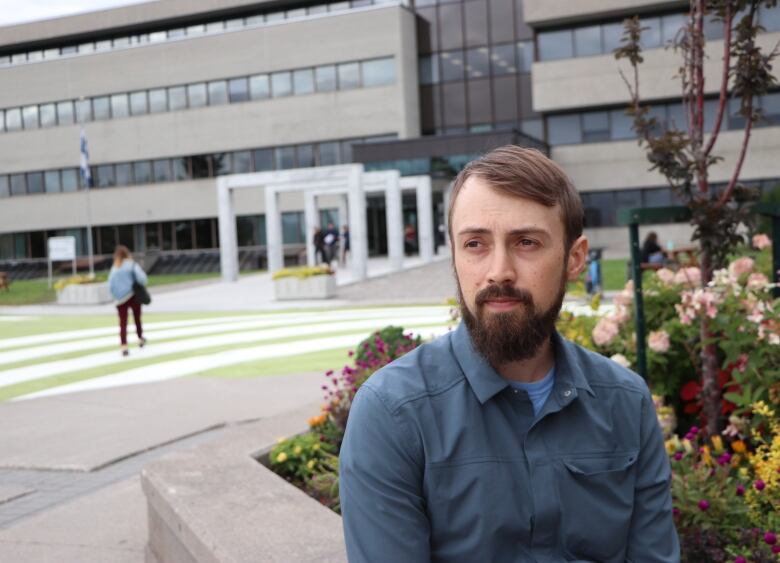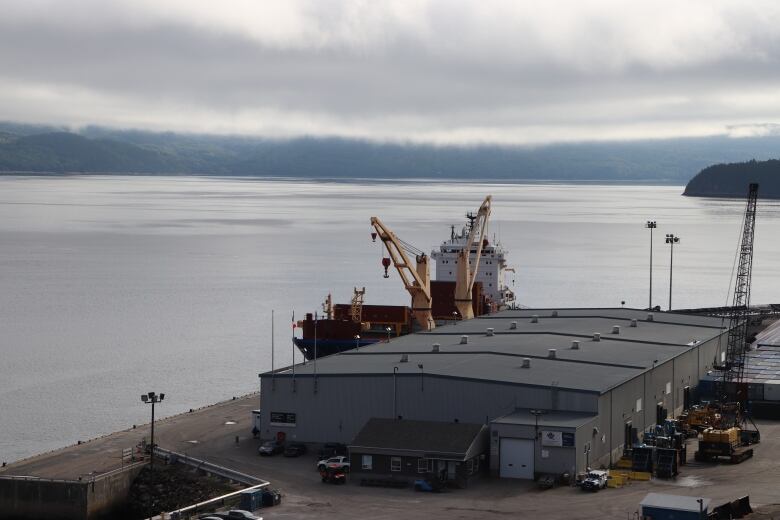How green is natural gas? The case for and against Quebec's nergie Saguenay project
Promoters face tough questions over claims the $14B pipeline and LNG plant will cut greenhouse gas emissions

nergie Saguenay, a proposed $14-billion pipeline and LNG terminal, is the largest private investment project in recent Quebec history. But do Saguenens want it?CBC Quebec travelled through the region to find out what's at stake. Here is the first in a series.
The wrenching debate over fossil fuels and climate change is lapping up against the shores of the magnificent Saguenay Fjord in the heart of Quebec.
Here, just upstream from the Saguenay-St. Lawrence Marine Park a protected area for the endangered beluga whale two major, intertwined projects are in the planning and evaluation stages.
Gazoduc is to deliver Alberta natural gas through an as-yet unbuilt, 782-kilometre pipeline extending from northern Ontario through Quebec's Abitibi and Lac-Saint-Jean regions.
If the project gets approval, it would be an important boost for an industry struggling to get its product to market.

The gas that comes down that pipeline would be transformed by GNL Qubec at a liquified natural gas (LNG) plant in the Port of Saguenay.
Its promoters say it would be among the greenest LNG plants in the world. Tanker ships would carry the LNG from the marine terminal, down the Saguenay Fjord and on to markets in Europe and Asia.
At a combined estimated cost of $14 billion, the pipeline and LNG plant would form Quebec's largest privately funded industrial project in decades.
The projects would create at least 10,000 jobs during the construction phase and about 1,100 permanent direct and indirect jobs once in operation, stimulating economic diversification.
But standing in the way are profound concerns about increased greenhouse gas (GHG) emissions, with many demanding action in the face of the global climate crisis.

The challenge
Saguenay Mayor Jose Nron can feel the conflict.
Her city is still plagued by high unemployment, even while the province enjoys its lowest overall unemployment rate in more than 40 years.
An LNG plant offering good, well-paying jobs would help retain young people and stimulate the creation of spin-off projects.
However, GNL Qubec faces a challenge, Nron said.
"People are in the streets are talking about the environment," she said. "You have to reassure the population that you're a company that has the environment as its number one concern, and you're not afraid to make a commitment before you start to build your plant."
Pat Fiore, GNL Qubec's president, says the company is committed to two things: building a plant that will be carbon-neutral, and replacing coal or oil in export markets.
"The whole genesis of this project is to minimize the impacts in Canada, in Quebec and displace more polluting fuels elsewhere in the world," Fiore said in an interview.
To meet those commitments, the company commissioned biologist and research scientist Claude Villeneuve, the chair of the eco-advisory council at l'Universit du Qubec in Chicoutimi, to advise it on what to do about CO2 emissions.

"I don't recommend anything," Villeneuve said. "They are responsible for their intent to become carbon-neutral. If they are serious, they will do it. If they are just lip-servicing, they will not."
"Prof. Villeneuve and his team have done an amazing job," said Fiore. "He's helped us open the window to look at new paths that we haven't thought about the use of the CO2 itself, the potential for renewable natural gas."
"We're going to [send] all that to our designers. We think it will be a multi-pronged solution. It's a cumulative of all these things that we're going to do that are going to get us good results."
A no-go, for many
To date, though, some residents along the length of the proposed pipeline path and on both sides of the Fjord aren't buying Fiore's sales pitch.
Adrien Guibert-Betez, an organizer of the opposition group Coalition Fjord, doesn't think there is anything the promoter can do to make the project acceptable.
"All the scientists all over the world said that we have to cut our greenhouse gases, and by that, we have to stop the utilization of gas and petrol and coal. So at thefoundation itself, the project is not a good project."
Guibert-Betez's coalition has been mobilizing residents along the Saguenay Fjord who question whether a company should contribute to the production of natural gas at all, regardless of its environmental commitments.

In June, a group of 160 Quebec scientists signed an open letter calling on the federal and Quebec governments to reject the projects because they are "incompatible with the idea of energy transition."
"It is essential to reduce the number of infrastructures linked to fossil fuels and not build more," they wrote, in order to meet the 2050 goal of carbon neutrality.
"The total emissions connected to the project in Canada would be comparable to the total of Quebec's GHG reductions since 1990," concluded the two principal authors of the letter, Universit Laval chemistry Prof. Jesse Greener and Universit du Qubec Montral environmental science Prof. Lucie Sauv.
That total, the scientists said, doesn't take into account leakage, known as fugitive emissions, along the way.
"Since natural gas is essentially made up of methane, a greenhouse gas that is 84 times more powerful than CO2 over a 20-year period, the contribution of these leaks to planetary warming is enormous," they wrote.
"So it is possible that the total GHG emissions associated with the project will be considerably higher than the best available estimates."
'A fraction of the footprints of any other plant'
So why in the world would someone want to build an LNG plant at the inland port of Saguenay, at the end of a fjord?
Why, when it requiresthe long extension of a pipelineto bring in the natural gas, and tanker ships longer than the Queen Mary cruise ship to move the liquified gasout to the St. Lawrence River where those tankers must passthrough the reproductive site of the endangered belugas before goingon to export markets?
One big reason is the abundant availability of hydro power. The ability to power a plant with clean hydroelectricity dramatically reduces greenhouse gas emissions normally associated with LNG plants.
Another is the Saguenay region's cool climate, which saves on energy costs.
That's important, because the liquefaction process involves running the natural gasthrough a series of giant refrigerators, where it is cooled to the point where it turns into a liquid, at 162 degrees Celsius.

These factors, says GNL Qubec's president, "make our [carbon] footprint a fraction of the footprints of any other plant in the world."
They are what Fiore says Jim Illich saw when he started scouting the continent for potential LNG plant sites.
Illich, the owner of Freestone International, a U.S. company that develops innovative energy projects, is the co-founder and key investor in nergie Saguenay, along with Jim Breyer of the U.S.-based Breyer Capital.
A total of 16 Canadian, American and Asian investors are now on board.
GHG footprint, from beginning to end
It istheoretically possible to make the liquefaction plant carbon-neutral through a series of other measures. But this is just one part of the LNG/greenhouse gas equation.
GNL Qubec commissioned a life-cycle analysis of the project, from the moment the gas is extracted in Alberta all the way to its arrival at the plant in Saguenay and then on to export markets aboard tankers.
The analysis was conducted by Polytechnique Montral's CIRAIG, the International Reference Centre on the Life Cycle of Products, Processes and Services.
It concluded a total of 7.8 million tonnes of greenhouse gases would be produced annually.
But Fiore says the CIRAIG life cycle analysis indicates the project globally "would remove 28 million tonnes of CO2 per year, which means every three years of production, we're eliminating all of Quebec's [annual] greenhouse gas emissions."
CIRAIG's analysis makes it clear that this is the best-case scenario and presumes that all the liquefied natural gas shipped out by GNL Qubec would replace coal or oil.

However, "CIRAIG, or members of its expert review committee, are not in a position to endorse [the company's] market scenario," the report says.
It points out that what happens to the LNG after it leaves the plant is the most problematic: its transportation by tanker, re-gasification, transmission locally, and its end use, be it for heating, power generation or to power vehicles. Between 68 and 77 per cent of GHG emissions occur at this stage.
If GNL Qubec succeeds in replacing coal or oil, then "the result will be a global decrease of GHG emissions," the CIRAIG report concludes.
However, if it becomes simply another energy source in the market and does not replace coal or oil, "the result will be a global increase in emissions."
What about wind and solar?
Universit Laval's Greener says that last conclusion is important to highlight.
"That's the massive amount of the problem: its utilization or misutilization downstream," the chemistsaid. "Obviously, we can't even guarantee that this gas is not going to replace sustainable energy projects."
"So the report is being spun," Greener said.
"If we're supposed to assume the product is going to be replacing dirtier forms of energy, there's no guarantee of that. And if you just look at the energy needs across the world, it's much more likely that these products are simply going to add to current consumption, not replace."
Pierre-Olivier Pineau, the chair in Energy Sector Management at HEC Montral, was an external reviewer of the CIRAIG report. Pineau saysthat when the project is stacked up against other existing or proposed LNG projects in North America, GNL Qubec's plan is justifiable, as its plant emissions will clearly be lower.
He acknowledges the export market targeted by GNL Qubec has renewable energy options, such as wind and solar power.
"These options are very good, very competitive. But they are intermittent, and they are not easy to integrate into a grid, so you cannot switch to 100 per cent renewables very easily over the next 20 years," Pineau said.
"There will be increasing amounts of wind and solar energy in the electricity grid, but there will also be a demand for natural gas for electricity, but also for heating and for some industrial purposes."
"It will be difficult to get out of coal in those countries without using some natural gas."
In potential markets like China, Pineau says, natural gas could realistically replace coal. Replacing oil is more difficult, he says, "but in some cases it could be, for some transportation applications using LNG trucks instead of diesel trucks."

Limits of carbon neutrality
UQAC biologist Villeneuve says all the companies, from those that take the natural gas out of the ground to Gazoduq, which is to extend the pipeline, must take responsibility for their emissions.
The same thing goes for overseas purchasers of GNL Qubec's LNG, he said.
"If you sell to India to replace coal, the right thing to do will be for India to record the project under a clean development mechanism, to make it verified, and to sell offsets that's the way it will be recognized," said Villeneuve.
"But if I just say natural gas will replace coal, it's not true. There are limits, and these limits to claims of carbon neutrality have to be respected."
GNL Qubec's Fiore said the company can't offer guarantees about how its product will be used or if it will require verification, because of confidentiality provisions.
However, the world trend to move away from coal and oil continues, and because of GNL Qubec's commitments to being green, he said, "We're attracting the best of the best."
With files from Julia Page












_(720p).jpg)


 OFFICIAL HD MUSIC VIDEO.jpg)
.jpg)



























































































